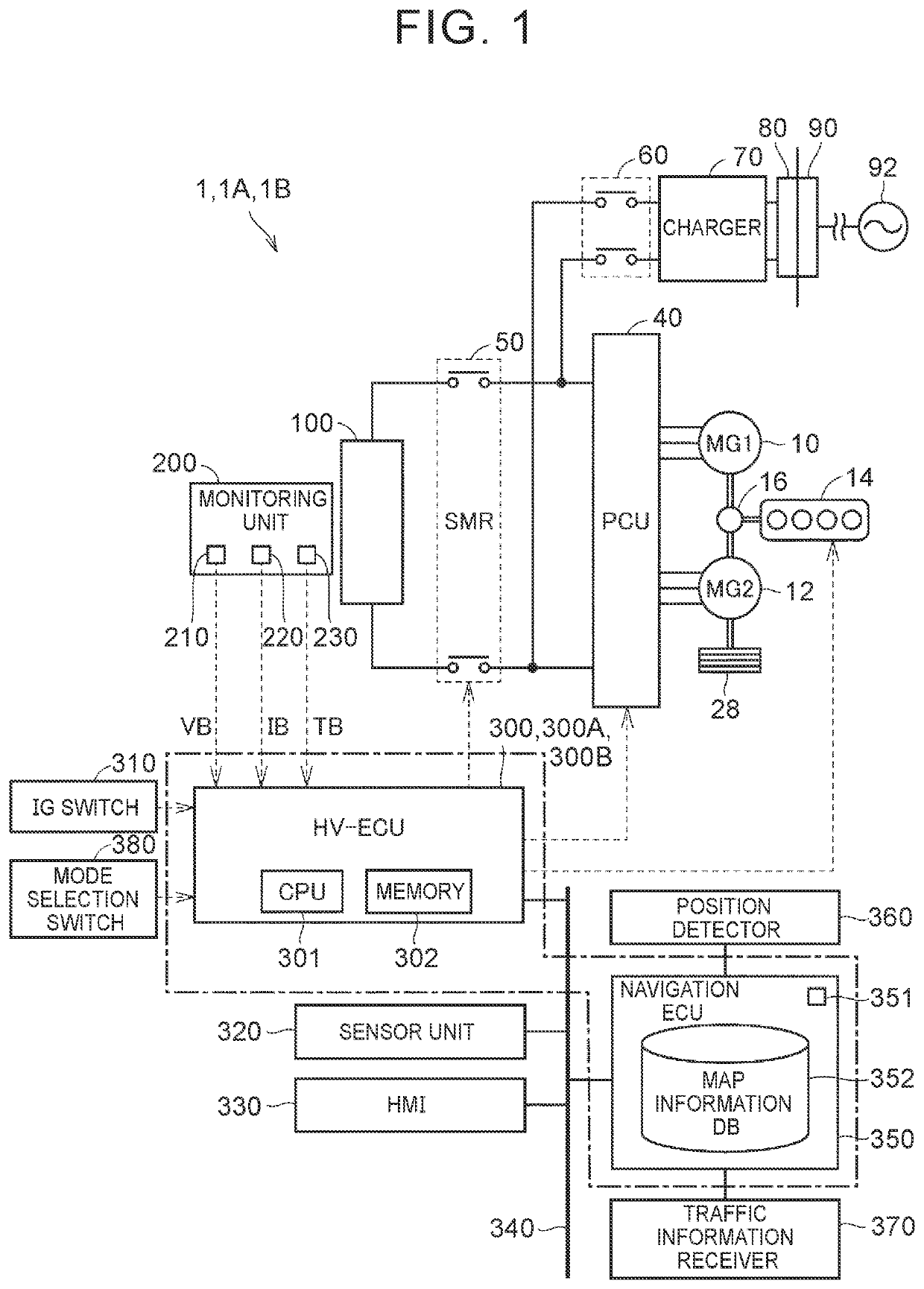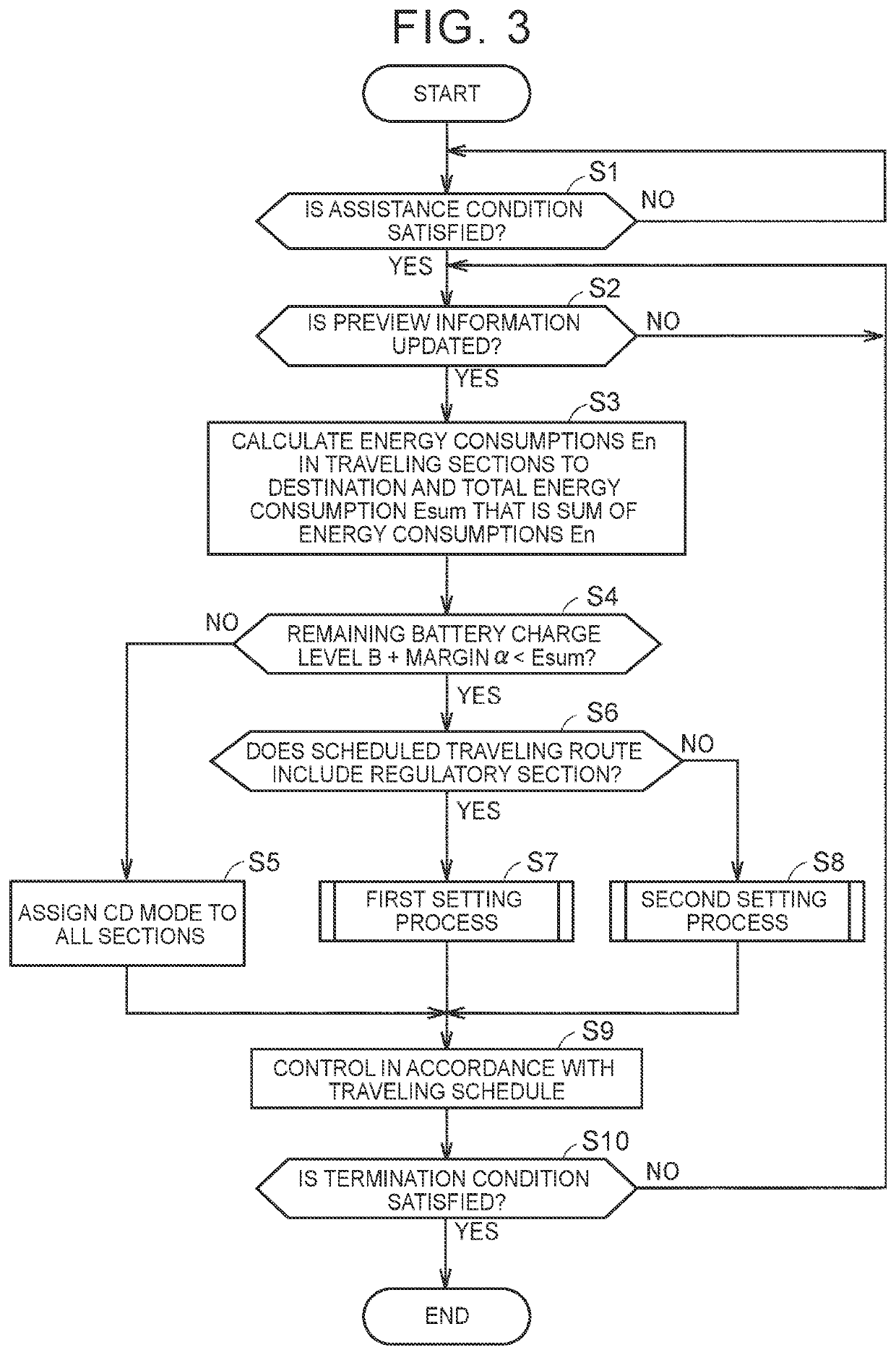Hybrid vehicle
a hybrid vehicle and hybrid technology, applied in the direction of control devices, external condition input parameters, transportation and packaging, etc., can solve the problems of difficult prediction of decreased charging/discharging efficiency of the battery, and difficulty in predicting electric power consumption in the battery
- Summary
- Abstract
- Description
- Claims
- Application Information
AI Technical Summary
Benefits of technology
Problems solved by technology
Method used
Image
Examples
first embodiment
Overall Configuration
[0044]FIG. 1 is an overall configuration diagram illustrating an example of a hybrid vehicle according to a first embodiment. Referring to FIG. 1, a hybrid vehicle (hereinafter also referred to simply as “vehicle”) 1 is a so-called series-parallel (split) hybrid vehicle. The vehicle 1 is not limited to the series-parallel hybrid vehicle, and may be, for example, a parallel or series hybrid vehicle. The vehicle 1 can externally charge an on-board battery (battery 100 in FIG. 1) by using electric power supplied from a power supply outside the vehicle (external power supply 92 in FIG. 1).
[0045]Referring to FIG. 1, the vehicle 1 includes a first motor generator (hereinafter referred to also as “first MG”) 10, a second motor generator (hereinafter referred to also as “second MG”) 12, an engine 14, a power split device 16, driving wheels 28, a power control unit (PCU) 40, a system main relay (SMR) 50, a charging relay 60, a charger 70, an inlet 80, the battery 100, a ...
second embodiment
[0127]The first embodiment is directed to the example in which, when the scheduled traveling route to the destination includes the regulatory section, the traveling schedule is set by executing the first setting process as the suppression process for suppressing the consumption of the electric power in the battery 100, thereby suppressing the exhaustion of the electric power in the battery 100 in the regulatory section. The second embodiment is directed to an example in which a suspension process for suspending the traveling assistance control is executed as the suppression process for suppressing the consumption of the electric power in the battery 100, thereby suppressing the exhaustion of the electric power in the battery 100 in the regulatory section. The suspension process according to the second embodiment is an example of “second process” of the present disclosure.
[0128]Referring to FIG. 1, a vehicle 1A according to the second embodiment differs from the vehicle 1 according t...
modified example 1
[0146]The first embodiment and the second embodiment may be combined together. Specifically, (1) the first setting process may be executed when the CD mode cannot be assigned to all the traveling sections on the scheduled traveling route and the scheduled traveling route to the destination includes the regulatory section, and (2) the suspension process may be executed when the suspension condition is satisfied. When the scheduled traveling route from the current position to the destination includes the regulatory section during the suspension of the traveling assistance control, traveling control may be executed so that the vehicle travels in the CS mode unless the current traveling section is the regulatory section.
[0147]FIG. 9 is a flowchart illustrating a processing procedure of the traveling assistance control in Modified Example 1. Details of processes in the flowchart of FIG. 9 are similar to the processes described in the first and second embodiments. Therefore, the same step...
PUM
 Login to View More
Login to View More Abstract
Description
Claims
Application Information
 Login to View More
Login to View More - R&D
- Intellectual Property
- Life Sciences
- Materials
- Tech Scout
- Unparalleled Data Quality
- Higher Quality Content
- 60% Fewer Hallucinations
Browse by: Latest US Patents, China's latest patents, Technical Efficacy Thesaurus, Application Domain, Technology Topic, Popular Technical Reports.
© 2025 PatSnap. All rights reserved.Legal|Privacy policy|Modern Slavery Act Transparency Statement|Sitemap|About US| Contact US: help@patsnap.com



